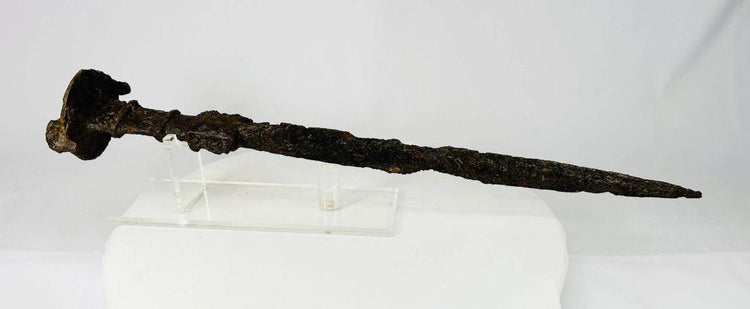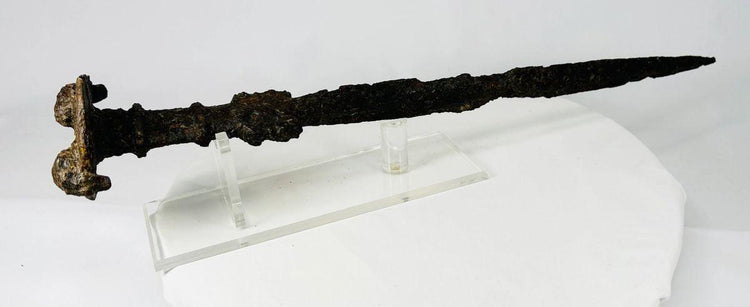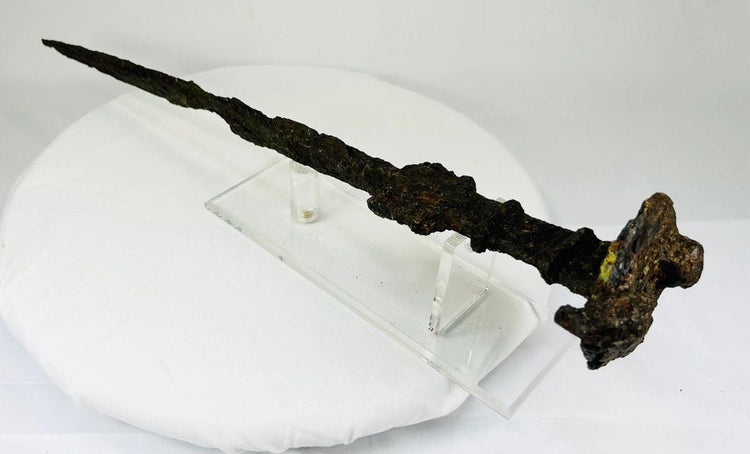Luristan | Épée courte en fer | Vers 750-650 av. J.-C.
Description
Plus
Moins
Contexte historique et origine
Région : Luristan, Iran occidental (Proche-Orient ancien)
Matériau : Fer
Période : Vers 750–650 av. J.-C. (âge du fer)
Description
Cette épée courte en fer du Luristan, rare et d'une importance historique, illustre le savoir-faire raffiné de l'âge du Fer. Mesurant environ 52,7 cm de long, elle se distingue par son pommeau en forme de disque à tête de lion, puissant symbole de force et de protection, et sa poignée nervurée, conçue pour une prise en main sûre et un raffinement esthétique. Malgré des millénaires d'enterrement, la lame a conservé ses proportions élégantes et sa forme originale, offrant un lien direct avec les traditions martiales et cérémonielles de l'ancien Luristan.
Caractéristiques
- Pommeau en forme de disque à tête de lion symbolisant l'autorité, la force et la protection
- Poignée nervurée, alliant design fonctionnel et détails artistiques
- Lame droite à double tranchant dont les proportions ont survécu intactes
- Patine naturelle et oxydation de surface compatibles avec un grand âge
Importance culturelle
Le Luristan était un centre d'innovation métallurgique durant l'âge du Fer, produisant des armes et des objets cérémoniels d'une remarquable facture artistique. Portées par les guerriers, ces épées revêtaient également une importance symbolique, servant de marqueurs de pouvoir et d'autorité. Le motif du lion, récurrent dans l'art du Luristan, renforçait les thèmes de domination, de protection divine et de statut social.
Condition
Bon état d'usage, avec une importante oxydation superficielle et une corrosion témoignant d'un enfouissement prolongé. Malgré l'usure due au temps, l'épée demeure structurellement stable, ses éléments clés, notamment le pommeau et la poignée, étant parfaitement préservés.
Dimensions
Longueur : 20,5 po
Âge
Vers 750–650 av. J.-C.
Description
Contexte historique et origine
Région : Luristan, Iran occidental (Proche-Orient ancien)
Matériau : Fer
Période : Vers 750–650 av. J.-C. (âge du fer)
Description
Cette épée courte en fer du Luristan, rare et d'une importance historique, illustre le savoir-faire raffiné de l'âge du Fer. Mesurant environ 52,7 cm de long, elle se distingue par son pommeau en forme de disque à tête de lion, puissant symbole de force et de protection, et sa poignée nervurée, conçue pour une prise en main sûre et un raffinement esthétique. Malgré des millénaires d'enterrement, la lame a conservé ses proportions élégantes et sa forme originale, offrant un lien direct avec les traditions martiales et cérémonielles de l'ancien Luristan.
Caractéristiques
- Pommeau en forme de disque à tête de lion symbolisant l'autorité, la force et la protection
- Poignée nervurée, alliant design fonctionnel et détails artistiques
- Lame droite à double tranchant dont les proportions ont survécu intactes
- Patine naturelle et oxydation de surface compatibles avec un grand âge
Importance culturelle
Le Luristan était un centre d'innovation métallurgique durant l'âge du Fer, produisant des armes et des objets cérémoniels d'une remarquable facture artistique. Portées par les guerriers, ces épées revêtaient également une importance symbolique, servant de marqueurs de pouvoir et d'autorité. Le motif du lion, récurrent dans l'art du Luristan, renforçait les thèmes de domination, de protection divine et de statut social.
Condition
Bon état d'usage, avec une importante oxydation superficielle et une corrosion témoignant d'un enfouissement prolongé. Malgré l'usure due au temps, l'épée demeure structurellement stable, ses éléments clés, notamment le pommeau et la poignée, étant parfaitement préservés.
Dimensions
Longueur : 20,5 po
Âge
Vers 750–650 av. J.-C.
Vous aimerez peut-être aussi






















